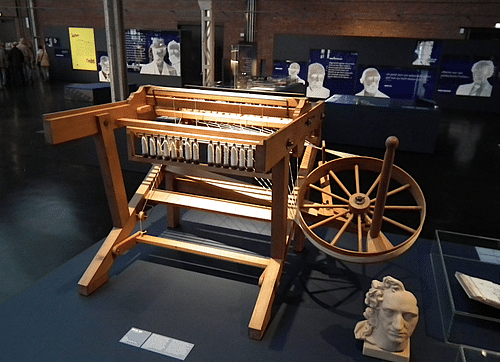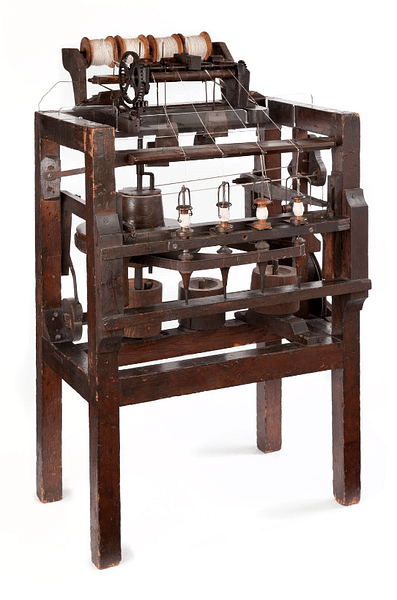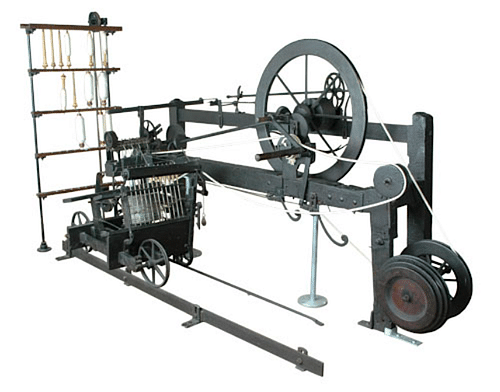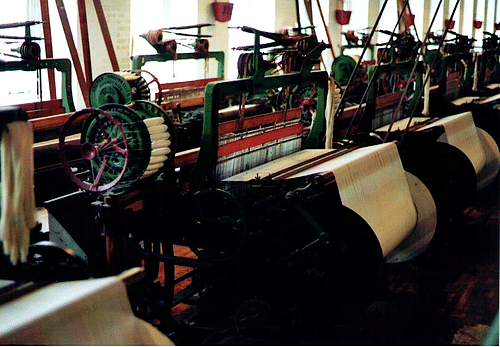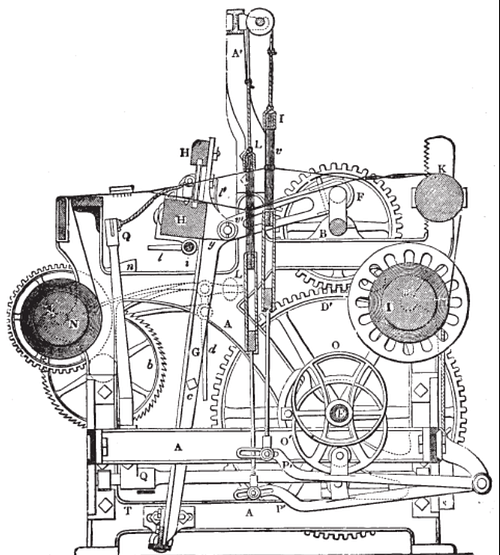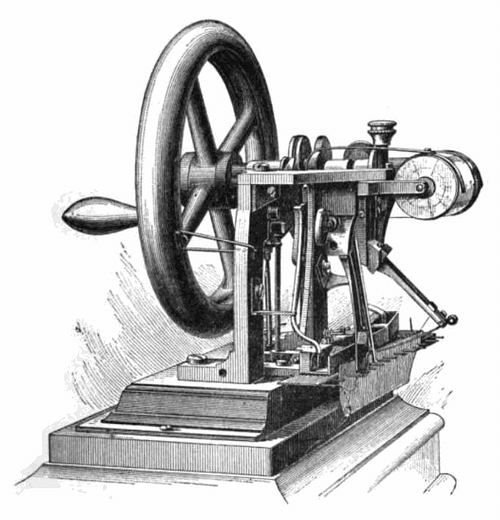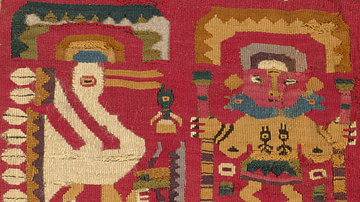During the Industrial Revolution (1760-1840), textile production was transformed from a cottage industry to a highly mechanised one where workers were present only to make sure the carding, spinning, and weaving machines never stopped. Driven by the desire to cut costs, a long line of inventors ensured that machine factories were cheaper, faster, and more reliable than ever before.
The adoption of machines, typically powered by water wheels and then steam engines, meant that many skilled textile workers lost their employment, which led to protest movements such as those by the Luddites. Although new, less skilled jobs were created, the poor working conditions in the textile mills helped form the trade union movement and spur governments to pass laws that protected the well-being of those who ensured the machines kept on spinning.
The Evolution of the Textile Industry
Traditionally, yarn and cloth were bought from spinners and weavers who worked in their own homes or in small workshops. It was common for a family to divide the work, with children washing and then carding the wool, women spinning the yarn using a manual spinning wheel, and men weaving the cloth using a hand-powered loom.
Production was greatly speeded up in 1733 when John Kay invented the flying shuttle, used to pull thread horizontally (weft) across longitudinal threads (warp) on a weaving frame. The shuttle, knocked across the worked material by a hammer, also permitted wider textiles to be made. The problem now was how to spin more yarn to keep pace with the faster weaving stage. The traditional spinning wheel was an efficient machine but could only spin one thread at a time. Consequently, inventors attempted to create machines that could spin multiple threads simultaneously. This would allow one operator to effectively do the work of several people. In addition, if many machines were all put in one place – a factory or mill – then production costs could be further reduced. As in many other areas of the Industrial Revolution, it was the lure of making more money that drove the move away from manual to machine labour.
There were many inventors and machines that pushed the textile industry forwards during the Industrial Revolution, but the most important include:
- The Spinning Jenny by James Hargreaves (1764)
- The Water Frame by Richard Arkwright (1769)
- The Spinning Mule by Samuel Crompton (1779)
- The Power Loom by Edmund Cartwright (1785)
- The Cotton Gin by Eli Whitney (1794)
- The Roberts' Loom by Richard Roberts (1822)
- The Self-Acting Mule by Richard Roberts (1825)
- Howe Sewing Machine by Elias Howe (1844)
Hargreaves' Spinning Jenny
James Hargreaves (1720-1778) invented the spinning jenny (machine) in Lancashire in 1764 (patented in 1770). The machine – essentially a spinning frame containing multiple spindles – could spin eight cotton threads at the same time, and so the potential to dramatically speed up production and cut labour costs attracted business owners. Hargreaves soon improved his jenny so that a single machine could spin 120 threads simultaneously. This evolution more than made up for the higher cost of a jenny compared to a traditional spinning wheel (70 shillings against one shilling). By 1788, factories across Britain were using over 20,000 spinning jennies. There was no going back to the old cottage industry of isolated workers in their homes, especially as many of the machines used large water wheels for their power.
Traditional textile workers immediately saw the threat of Hargreaves' jenny and smashed any examples they could find and, in some cases, even burnt down factories. Meanwhile, jennies were introduced to France directly from Lancashire from 1771, although they did not quite take off as they had in Britain, despite the French state subsidising their adoption. The reason may be due to wages being lower in France and so the expensive machines were a less attractive proposition for entrepreneurs. The same could also be true for India, where labour was cheaper still and where the jenny was largely ignored.
Arkwright's Water Frame
Richard Arkwright (1732-1792), a Lancashire wigmaker, created the first water frame, a device patented in 1769. Arkwright was crucially assisted by his friend John Kay, a clockmaker (not the flying shuttle inventor) who, over a period of five years, helped him perfect the right materials to use in the machine and the gears that made it work efficiently, replacing the more cumbersome system of levers and belts. As the economic historian R. C. Allen notes, "without watch-makers, the water frame could not have been designed" (204). Britain was at the forefront of watchmaking technology, and this again explains why it was here and not in other countries where the early textile machinery was pioneered. Not coincidentally, perhaps, the heart of the British clock industry was in Lancashire, precisely where the mechanised textile industry took off.
Arkwright's water frame was a cotton-spinning machine where rollers performed the task that fingers and thumbs once had. It was an improvement on the spinning jenny since it produced much finer and stronger yarn. An early version was powered by a single horse and could spin 96 spindles at once. As the fully-developed machine in Arkwright's factory in Cromford on the River Derwent (far away from any textile workers for his own safety and that of his machines) was powered by a water wheel, it could run indefinitely and more smoothly than hand-worked machines.
The 1771 version of Arkwright's water frame had 129 spindles and was operated by women since skilled male textile workers were no longer needed. The factory model of Cromford with its machines, layout, rationalised production process, provision of power on multiple floors, and full-time operations was copied in factories across the north of England, with Arkwright making a fortune by insisting buyers order no fewer than 1,000 of his machines at a time (or more accurately, the right to build them). The Cromford factory model was copied, too, in the United States and Germany. Arkwright also greatly improved his wealth by inventing a carding machine (patented in 1775), an invention that provided better quality source material for the spinning machines. The carding machine actually cut labour costs far more than the water frame.
Crompton's Spinning Mule
Samuel Crompton invented the spinning mule in 1779, an improved combination of Hargreaves' jenny and Arkwright's water frame that made finer and more uniform yarn. The machine could measure up to 46 metres (150 ft) in length and massively increased the number of available spindles. A single machine could have 1,320 spindles but was complex and needed three workers to operate it. The invention was a huge success, and by the 1790s, they were steam-powered. A single factory might have 60 of the machines, and soon there were 50 million mule spindles spinning away in Lancashire.
Cartwright's Power Loom
The next development was the power loom weaving machine, invented by Edmund Cartwright (1743-1823) in 1785. Cartwright was a former clergyman, and he was inspired to create the water- and then steam-powered loom after visiting a factory in Derbyshire. The fully automated machine only needed a single worker to change the full spindles every seven minutes or so. Cartwright's machine doubled the speed of cloth production but was not all that efficient; subsequent inventors worked on this problem with success, but Cartwright's theoretical principles were sound, and he himself never stopped improving his invention. The power loom was first used effectively in factories owned by Richard Arkwright. Textile factories across the country soon equipped themselves with hundreds of power looms. The British government awarded Cartwright £10,000 in 1809 in thanks for the significant contribution the power loom made to British industry. In 1821, Cartwright was made a Fellow of the Royal Society.
Whitney's Cotton Gin
As the methods of the spinners had to keep up with those of the weavers, so, too, those who supplied the raw cotton had to increase their production to meet the booming demand. Eli Whitney (1765-1825) from Massachusetts, USA, moved to a cotton plantation in Georgia where he created a way to efficiently separate the sticky seeds from cotton balls. Whitney's Cotton Gin ('gin' meaning 'machine') was invented in 1794 and was powered by horses or water wheels. It pulled raw cotton through a comb mesh where a combination of revolving metal teeth and hooks separated it and removed the troublesome seeds. A single cotton gin could process up to 25 kg (55 lbs) of cotton every day. Just like Crompton and Cartwright, Whitney's invention was a victim of its own success and was so widely copied that he made little money from it himself, despite registering it with the patent office. As cotton production rocketed, so more and more slaves were used on the cotton plantations to pick the cotton balls that fed the insatiable gins. Cotton was exported far and wide. In Britain in 1790, cotton accounted for 2.3% of total imports; by 1830, that figure had rocketed to 55%. British textile mills worked the raw material and exported it out again with such success that cotton textiles accounted for half of Britain's total exports in 1830.
Now, all three branches of the textile industry – raw material production, spinning, and weaving – could be fully mechanised, but still, the search for efficiency and great profits spurred on the inventors. Textile manufacturing was now big business despite the high costs to set up a machine factory, around £15,000 in 1793 (over $2 million today). As Allen notes, "Cotton was the wonder industry of the Industrial Revolution" (182).
Roberts' Loom
The first cast-iron loom powered by steam was invented by Richard Roberts (1789-1864) in 1822. Using iron instead of wood (as in Cartwright's loom) meant that the machine did not warp, and so the tension of the yarns was kept constant. There were now much fewer instances of yarns snapping or becoming so loose they got tangled in the machinery. This meant that the production of woven cloth was faster than ever.
The inventors kept on improving the machines, both in Britain and in other countries. From the 1790s, the British government prohibited the export of machinery to safeguard its competitive advantage, but, nevertheless, machines were smuggled out and used to set up mills in France, Belgium, and the Netherlands. The machines were more efficient than ever, and this meant that, despite the capital outlay required to acquire them, they became profitable even in places with much lower labour costs than in Britain.
A notable addition to a textile factory's repertoire was the calico (cheap cotton material) printing machine of c. 1780, which permitted patterned textiles to be made using pre-punched cards. The Frenchman Joseph-Marie Jacquard (1752-1834) developed a machine that could create patterned silk fabric around 1800, also using pre-cut cards. The Jacquard loom was adopted almost everywhere textiles were made.
Roberts' Self-Acting Mule
Richard Roberts continued to work on mechanised looms, and he came up with something new in 1825. Roberts' creative spirit was perhaps driven by self-interest since, once again, weaving had leapt forward thanks to his loom and spinning could not keep up and supply the yarns the weavers needed. This limited sales of the Roberts Loom. Roberts created a spinning machine that could run with very little input from humans, meaning they could run around the clock. The machine used gears, cranks, and a guide mechanism to ensure that yarn was always placed exactly where it should be and that spindles turned at varying speeds depending on how full they were (hence the machine's 'self-acting' name). Roberts' loom and mule combined provided mill owners with exactly what they had wanted: a factory floor with as few humans in it as possible.
By 1835, around 75% of cotton mills were using steam power, and there were well over 50,000 power looms being used in Britain. A steam-powered factory did not need to be located near a water source, so better sites could be chosen close to natural resources like coal. With ever more versatile, cheaper, efficient, and reliable machines, the textile industry had become almost completely automated, certainly to the extent that machine operators no longer needed any textile skills. Skilled workers lost their jobs to semi-skilled labourers, but there were more of the latter than the former thanks to the growth in the textile industry.
The British mechanized textile industry could now better its main rival India in production, and so exports boomed. Labour in India was cheap, but the British machines were faster, producing in 2,000 hours what an Indian 'factory' needed 50,000 hours to achieve. In short, the British "cotton mill of 1836 was so efficient that it could out-compete hand spinning anywhere in the world" (Allen, 187).
Howe's Sewing Machine
Elias Howe (1819-1867) invented a new type of sewing machine in Cambridge in the United States in 1844 (patented in 1846). It was the first machine to use the lockstitch (where there are two threads put in the cloth, one from below and one from above). The lockstitch made textiles much stronger since even if the thread broke the whole line of stitches did not unravel. The machine was far quicker than a person sewing by hand – 640 stitches per minute compared to the average of 23 by hand. Consequently, "a calico dress took around six and a half hours to make by hand but just under an hour by machine. The clothing industry was completely revolutionised" (Forty, 149). There were soon imitation companies, notably that owned by Isaac Merritt Singer, who was obliged to pay royalties to Howe and give him a share in I. M. Singer and Co., a company which went on to become one of the leading sewing machine manufacturers, selling some half a million machines each year by 1870. Howe kept on developing his idea, making smaller machines and adding a power source from a foot pedal, which meant that the textile industry went full circle, and once again, people had the opportunity to produce clothes and other textiles in their own homes.
Consequences: The Luddites
Machines meant textile products were cheaper to buy for everyone, and supply industries like the cotton plantations and coal mines boomed. The increase in the number of factories meant many new jobs were created, albeit largely unskilled work. The populations of cities and towns like Manchester, Liverpool, Sheffield, and Halifax increased ten times over in the 19th century as people in the countryside flocked to cramped and unsanitary urban centres to find work.
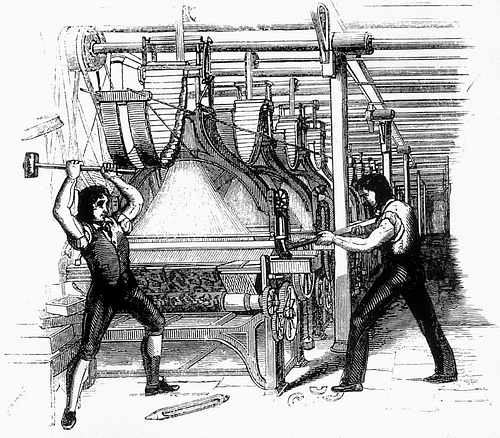
The arrival of machines put a lot of skilled textile workers out of a job, and many protested violently against the loss of their livelihood or the reduction in their wages. In the great manufacturing cities of Yorkshire, Lancashire, and Nottinghamshire between 1811 and 1816, a new protest group emerged, the Luddites, named after their mythical leader Ned Ludd, aka King Ludd. The Luddites broke into factories and smashed the machines that had taken away their jobs. The Establishment fought back. Handsome cash rewards were offered for information on or for the capture of Luddites, and the army was called in to protect factories and their owners. Those protestors who were caught faced harsh penalties that included hanging or deportation to Australia.
Working Conditions & Trade Unions
Workers in textile mills had to put up with difficult conditions. Not only were the machines noisy and sometimes dangerous when they failed (falling heavy parts and shuttles flying out like missiles with alarming regularity), but in order to keep the cotton thread supple and strong, the atmosphere in a factory was deliberately kept warm and damp. Such conditions meant that many workers suffered health problems, particularly with their lungs.
A working day in a factory was long, typically 12 hours and included night work as factories and their machines worked around the clock. Many employers preferred women and children to men as they were cheaper. Children were employed, too, because they could crawl under the machines to clear up cotton waste and prevent hanging threads clogging the machinery, all too often a lethal task. As money and efficiency became the obsession of many mill owners, workers were increasingly pressured to work faster and not cause delays in production. There were fines for workers with dirty hands or those who took too long on a toilet break.
All of these negatives meant that workers eventually grouped together to protect their interests. Trade unions were formed to try and curb the greater abuses from unscrupulous employers. Unions collected funds to help those who were ill or injured and so unable to work or be paid. Owners did not like these limits on their profits, and the government banned trade unions between 1799 and 1824, but the movement to protect workers could not be stopped indefinitely.
Several acts of Parliament were passed from 1833 to try, not always successfully, to limit employers' exploitation of their workforce and lay down minimum standards. New regulations included the minimum age children could work, the length of shifts, the prohibition of night work for women and children, the obligation for owners to build protective screens for the more dangerous machines, and the appointment of government inspectors. Textile factories offered valuable employment, but they remained noisy, dangerous, and unhealthy places to spend most of one's waking hours in. The poet William Blake's 1808 description of factories as "dark satanic mills" (Horn, 52), sadly, remained apt long after the Industrial Revolution had passed.


